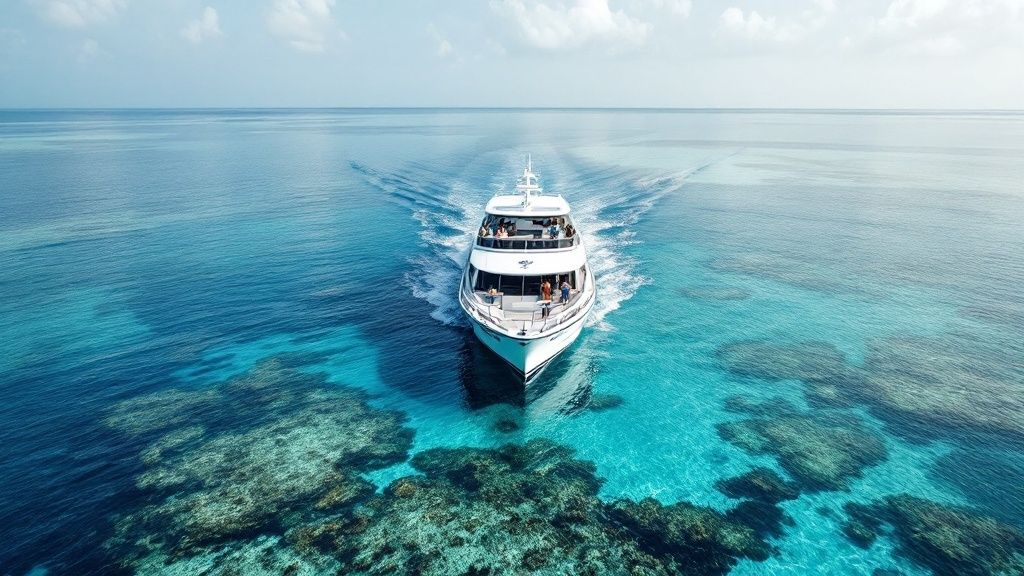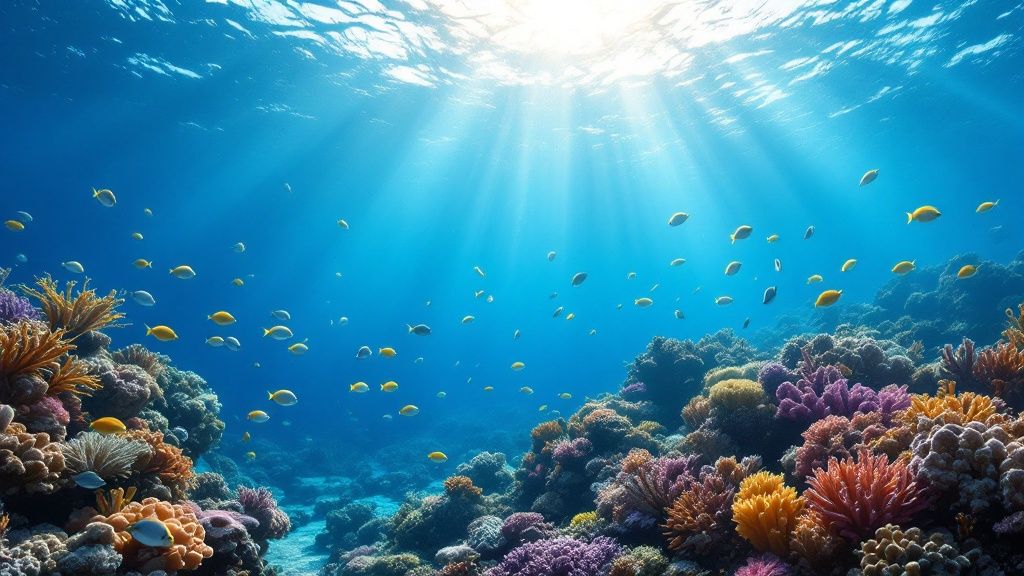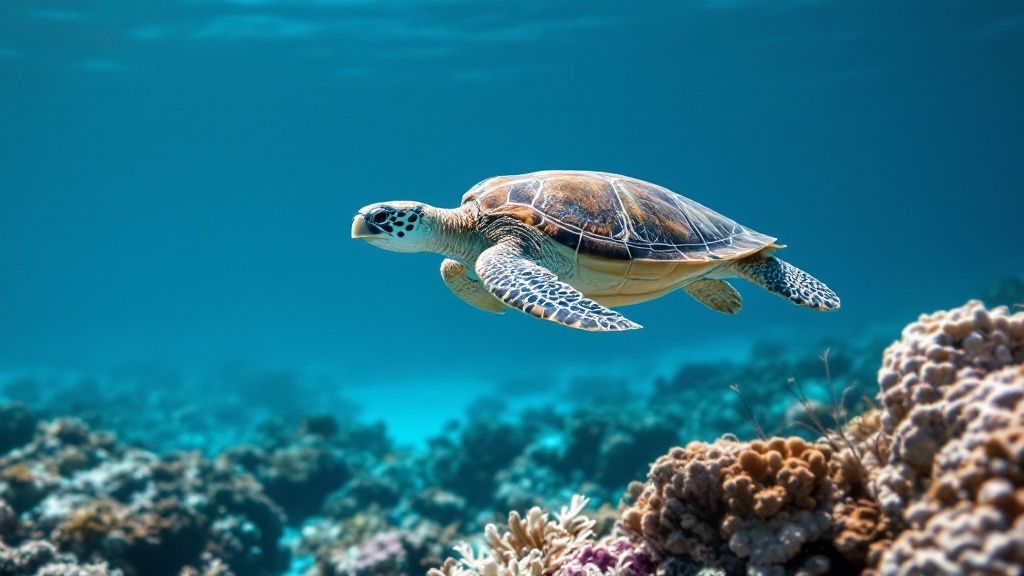Captain Cook Snorkel Tour Your Guide to Kealakakua Bay
- Kona Snorkel Trips
- Sep 15
- 13 min read
Picture yourself gliding through warm, turquoise water, totally surrounded by a kaleidoscope of tropical fish and vibrant coral reefs. This is the heart of the Captain Cook snorkel tour, a legendary Big Island adventure that's as rich in history as it is in natural beauty. It’s way more than just a swim—it's a chance to dive into one of Hawaii's most pristine marine sanctuaries.
Experience an Unforgettable Snorkeling Adventure
This guide is your complete walkthrough for the tour, covering everything from the historical importance of the Captain Cook Monument to the incredible marine life you'll meet in Kealakekua Bay. But first, let’s see what fellow travelers have to say. Their own words really capture the magic of a day spent in these protected waters. The Manta Ray Night Snorkel Hawaii is another incredible adventure worth considering.
As you can see, people consistently rave about the crystal-clear water, the sheer amount of wildlife, and the top-notch quality of the whole experience. It's a standout for a reason.
Why Kealakekua Bay Is A Premier Destination
Kealakekua Bay isn't just another pretty spot to snorkel; it's a designated Marine Life Conservation District. This special protection means the coral reefs are ridiculously healthy and packed with an amazing diversity of fish. The bay is also naturally calm and sheltered, making it perfect for everyone from first-time snorkelers to seasoned pros.
While the Captain Cook snorkel tour is a classic, the Big Island has other world-class marine adventures, too. If you're looking for an exceptional alternative, Kona Snorkel Trips runs fantastic excursions for a Captain Cook snorkeling tour and also offers the world-famous Manta Ray night snorkel tour. Taking both gives you the ultimate Hawaiian water experience, showing off the very best of the Kona coast.
The sheer density of marine life in Kealakekua Bay is astounding. On a typical tour, it's not uncommon to see hundreds of tropical fish, graceful sea turtles, and even playful spinner dolphins on the boat ride over.
Whether you're a history buff drawn to the monument's story or an ocean lover ready to explore a thriving reef, this adventure delivers. Ready to see it for yourself? You can start planning your own Captain Cook excursion and experience the magic firsthand.
This guide will get you fully prepped for an incredible day on the water, making sure you get the most out of your visit to this historical and ecological treasure.

A Journey into the History of Kealakekua Bay
Your captain cook snorkel tour is so much more than just a swim—it's a trip back in time. The calm, turquoise waters of Kealakekua Bay hold stories that are absolutely central to Hawaiian history, and every paddle stroke brings you closer to the profound events that unfolded right here.
Looming against the lush green cliffs, you can't miss the stark white obelisk of the Captain Cook Monument. It’s more than just a landmark; it’s a tombstone marking the approximate spot where the famous British explorer Captain James Cook was killed in 1779 during a fierce clash with Native Hawaiians.
Knowing this story completely changes your perspective. It adds a powerful layer of meaning to the vibrant reefs just below the surface. This history is complex, filled with moments of awe, deep cultural misunderstandings, and ultimately, tragic conflict.
The Arrival and a Fateful Encounter
Captain Cook's timing couldn't have been more incredible. When he first sailed into Kealakekua Bay in 1778, it was right in the middle of the Makahiki festival—an annual season of peace and tribute to the Hawaiian god Lono. The sails on his ships, to the Hawaiians watching from shore, looked uncannily like the banners used to honor Lono. It's no wonder many believed Cook himself was a manifestation of the god.
What followed was a period of peaceful exchange, with both sides fascinated by the other. But when Cook returned, things had changed. Tensions flared, and a series of disputes spiraled out of control when Cook attempted to take a high-ranking chief hostage. The confrontation turned violent, and it ended with his death right here in the bay. To really get into the details, you can read more about the history of Captain Cook's 1778 encounter in Hawaii.
This single event marked the first major European contact with the Hawaiian people, forever changing the course of their history. It's a huge part of what makes these tours so compelling. In fact, some studies show that around 70% of visitors come here specifically because they're drawn to this incredible historical story. You can discover more insights about the historical draw of Kealakekua Bay on konaoceanadventures.com.
A Legacy of Preservation
But the bay's story didn't start with Captain Cook. Long before his ships ever appeared on the horizon, Kealakekua ("the pathway of the god") was a place of immense cultural and spiritual power for Native Hawaiians, home to villages, sacred temples (heiau), and thriving communities.
It’s this deep past that explains why the area is so fiercely protected today. Kealakekua Bay holds a special dual status as both a State Historical Park and a Marine Life Conservation District. This protection is designed to preserve both its history and its delicate ecosystem, ensuring one doesn't exist without the other.
The legacy of Kealakekua Bay is a powerful reminder of how history and nature are intertwined. The efforts to protect its cultural sites are directly linked to the health of its marine sanctuary, creating a unique environment where the past and present thrive side by side.
What this means for you is that when you dip below the surface, you’re literally swimming through living history. The healthy corals and schools of fish are thriving in a place that’s sacred—protected not just for its natural beauty, but for its deep, undeniable cultural roots.
Exploring Kealakekua Bay's Underwater World
Beneath the calm, shimmering surface of Kealakekua Bay lies a vibrant city of coral and color. It's a spectacular underwater world just waiting to be explored on your captain cook snorkel tour. This place isn't just beautiful; it's a protected Marine Life Conservation District, meaning the reef is flourishing and marine creatures can live totally undisturbed. High cliffs surround the bay, sheltering it from the open ocean swells and creating those famously clear and calm conditions that make this one of the top snorkeling spots in Hawaii.
The moment you dip your face in the water, you'll see this underwater paradise is absolutely buzzing with activity. Imagine floating weightlessly above intricate coral gardens, which form the foundation for this entire ecosystem. These living structures provide food and shelter for hundreds of species, creating a perfectly balanced natural aquarium where every inhabitant plays a crucial role.

A Cast of Colorful Characters
The first thing you’ll notice is the sheer abundance of fish. Schools of brilliant yellow tang move like flashes of sunlight through the water, while ornate butterflyfish flutter gracefully among the coral branches. You'll want to keep an eye out for the majestic parrotfish—they're easy to spot with their beak-like mouths, which they use to nibble on algae, keeping the reef clean and healthy.
Other common residents you’ll almost certainly run into include:
Humuhumunukunukuāpuaʻa: Hawaii's state fish! It's a type of triggerfish known for its wild patterns.
Moorish Idol: A striking black, white, and yellow fish with a long, flowing dorsal fin.
Moray Eels: Don't be surprised to see them peeking out from crevices in the coral. They’re more curious than anything else.
And it's not just the smaller reef fish. Kealakekua Bay is a frequent hangout for larger marine life. It’s very common to spot a Hawaiian Green Sea Turtle, or honu, gliding effortlessly through the water. These gentle giants are a protected species and a true symbol of the Hawaiian islands.
Why Kealakekua Bay is So Special
The bay's popularity is no secret; it welcomes over 190,000 visitors each year. While about 70% of those visitors are drawn by the rich history of Captain Cook, the other 30% come specifically for the incredible underwater world. Because it's a protected area, the bay boasts visibility that can reach up to 100 feet, allowing you to see over 200 species of fish in exceptionally calm waters.
On the boat ride over, it’s also pretty common for pods of playful spinner dolphins to put on a show, leaping and spinning in the boat’s wake. Their acrobatic displays are a thrilling bonus to an already amazing day.
The pristine condition of the reef is a direct result of its protected status. Snorkeling here offers a rare glimpse into what a healthy, thriving Hawaiian marine ecosystem looks like, making it a powerful educational experience as well as a beautiful one.
This incredible biodiversity makes every snorkeling trip unique. You never know what amazing creature you might encounter next. If you're eager to learn more about the specific marine life you'll see, you can dive deeper into our guide about snorkeling Kealakekua Bay's hidden Hawaiian reefs.
How to Choose Your Perfect Snorkel Tour
With so many companies offering tours to Kealakekua Bay, picking the right one can feel a little dizzying. But here's the good news: that variety means there's a perfect trip out there for you, whether you're looking for a quiet, up-close snorkel session or a lively family adventure with all the fixings.
The first big choice you'll make is the boat itself. Are you a large catamaran person or a smaller, zippy zodiac-style boat person? Each one offers a totally different vibe for your day on the water.
Big boats often come loaded with comforts like bathrooms, lunch service, and sometimes even water slides. Smaller boats, on the other hand, deliver a more personal experience. They get you much closer to the shoreline, zipping into sea caves and lava tubes that the bigger boats just can't reach.

Comparing Your Tour Options
Let's break down the common choices to make this decision a bit easier. Think about who you're traveling with, your budget, and what kind of memories you want to make. Are you bringing young kids who need space and easy access to the water? Or are you an adventurous couple hoping for a more rugged, intimate look at the Kona coast?
A Captain Cook snorkel tour can mean a lot of different things. Typically, the smaller boat tours run for 3 to 4 hours and take out just 6 to 12 guests, with prices falling between $80 and $180. The bigger catamaran trips are usually longer, lasting 4 to 5 hours with 20 to 40 passengers on board, and run from about $100 to $220. If you want the ultimate private experience, you can charter a boat, with prices usually starting around $500.
To help you visualize the differences, here’s a quick breakdown of the most common tour types.
Captain Cook Snorkel Tour Comparison
Tour Type | Best For | Typical Group Size | Common Amenities | Average Price Range |
|---|---|---|---|---|
Large Catamaran | 20-40+ passengers | Onboard restrooms, shaded seating, lunch/snacks, often has slides or fun water toys. | $100 - $220 | |
Small Zodiac/Boat | Couples, solo travelers, and adventure seekers wanting a more intimate feel. | 6-12 passengers | Basic gear, a more personal guide-to-guest ratio, ability to explore smaller coves. | $80 - $180 |
Private Charter | Special occasions, groups wanting total control over the itinerary. | 1-12+ (your group) | Fully customizable, can include high-end food, drinks, and personalized routes. | $500+ |
This table should give you a solid starting point for figuring out what kind of day you're after.
Matching a Tour to Your Travel Style
Let's put this into practice. If you're a family with younger kids, a large catamaran is almost always your best bet. The boat's stability is a huge plus for preventing seasickness, and having a bathroom and lunch included just makes the day so much easier. The extra space gives kids room to move around, and the crew is used to helping guests of all ages.
On the flip side, if you're a couple or a small group of friends who are strong swimmers and up for an adventure, a smaller zodiac is the way to go. These tours feel less like a tour and more like an expedition. The small group size means you get way more time to chat with the guide, who can point out all the cool marine life and share the history of the bay. You'll feel the ocean spray and get an incredible, up-close view of the dramatic coastline.
For a deeper look, check out our guide on the top 5 Captain Cook snorkel tours in 2025 where we review some of the best operators out there.
The "best" tour really just comes down to you. Figure out your priorities first—whether it's comfort, adventure, or budget—and then find the trip that matches.
Once you’ve landed on the right style of tour, the next thing to do is book it. These trips are incredibly popular and fill up fast, especially during the busy seasons. Booking ahead of time is the only way to guarantee you won't miss out.
Preparing For Your Day On The Water

A little prep work can make the difference between a good day and a truly unforgettable one. When you step onto the boat for your Captain Cook snorkel tour, the last thing you want to be thinking about is what you forgot to bring.
Being ready with the right gear lets you just sink into the experience. This guide will walk you through exactly what you need for a comfortable, safe, and incredible trip out to Kealakekua Bay. We’ll cover the must-haves, the nice-to-haves, and one item that’s non-negotiable for protecting the very reef you're about to explore.
Your Captain Cook Snorkel Tour Packing Checklist
Packing for a snorkel trip is all about being smart, not bringing the entire closet. Most quality tours provide the essential gear—mask, snorkel, and fins—but it's the personal comfort items that really elevate your day.
The Hawaiian sun is no joke, especially when it’s bouncing off the water. Your best strategy is to think in layers and prioritize sun protection. Here’s a quick-reference guide for everything you need for a perfect day.
Item Category | Essential Items | Optional but Recommended |
|---|---|---|
Apparel | Swimsuit, Cover-up or T-shirt, Hat, Polarized Sunglasses | Long-sleeve rash guard (for sun protection), Change of clothes |
Protection | Reef-Safe Sunscreen (mineral-based, no oxybenzone) | Lip balm with SPF, Aloe vera gel (for after) |
Gear | Reusable water bottle, Towel, Waterproof bag for electronics | Underwater camera (like a GoPro), Anti-fog spray for your mask |
Personal | Any necessary personal medications, Cash for gratuities | Snacks (if not provided), Waterproof phone case |
Having these items on hand means you can focus on the amazing scenery and marine life, not a nasty sunburn or a dead phone.
Why Reef-Safe Sunscreen Is A Must-Have
This is so important it deserves its own spotlight. Many common sunscreens contain chemicals like oxybenzone and octinoxate, which are devastating to coral reefs. Studies have shown they cause coral bleaching, damage coral DNA, and stop young coral from growing.
When you pack a mineral-based sunscreen that uses zinc oxide or titanium dioxide, you're making a conscious choice to protect the underwater world you came to see. It’s more than just a recommendation here in Hawaii; it’s a crucial part of preserving the magic of the Captain Cook snorkel tour.
By simply choosing a reef-safe sunscreen, you become an active participant in the conservation of Kealakekua Bay. It’s one of the easiest and most impactful ways to ensure these beautiful coral gardens thrive for future generations.
Onboard Safety And Best Practices
Once you’re on the boat and cruising down the coast, the real fun begins. Your crew is your best resource for a safe and incredible time, so their pre-snorkel briefing is mandatory listening.
Pay close attention to what they say. They know these waters like the back of their hands and will cover everything from fitting your mask correctly to pointing out the safest spots to get in and out of the water.
Keep these simple practices in mind:
Listen to the Crew: Their briefing has everything you need to know about the day’s conditions, safety protocols, and what to look for.
Use the Buddy System: Never snorkel alone. It’s safer and way more fun to point out cool fish to someone.
Stay Hydrated: The sun and salt can dehydrate you quickly. Drink water constantly throughout the tour.
Know Your Limits: Don’t push it. If you're not a confident swimmer, there’s no shame in using a flotation device—they're there for a reason!
By packing smart and listening to the pros, you’ll be all set to kick back, relax, and soak in every moment of your adventure. For a deeper dive into making the most of your time in the water, check out our guide on the top 6 Captain Cook snorkeling tips for 2025.
Got Questions? We've Got Answers.
Even with all the excitement about the history and incredible sea life, you probably have a few practical questions kicking around. We get it. Let’s clear up the common things people ask so you can book your trip with total confidence.
We've pulled together the top questions we hear from travelers just like you and laid out the answers, plain and simple.
Is This Tour Okay for a Total Beginner?
Absolutely. In fact, it’s one of the best places on the Big Island for first-timers. The waters at Kealakekua Bay are famously calm and protected, almost like a giant, natural swimming pool. High cliffs shield the bay from the open ocean swells, which means there’s hardly any current and the visibility is often crystal clear up to 100 feet.
It's the perfect spot to get your fins wet without any stress. Tour crews provide all the gear you need, including floatation devices like pool noodles or life vests, and they'll give you a quick, easy lesson on how to use everything. They're always on watch, making it a super safe and welcoming place for everyone, from kids to grandparents. For a really great, safety-focused experience, check out operators like Kona Snorkel Trips, who specialize in making everyone feel comfortable in the water.
Will I See Dolphins or Whales?
There's a very good chance! It’s super common to spot pods of Hawaiian spinner dolphins on the boat ride to and from the bay. These guys are famous for their playful acrobatics—leaping and spinning right in the boat's wake. While you can never guarantee a wildlife sighting, it happens often and adds a whole extra layer of magic to the trip.
And if you're here during whale season (December to March), keep your eyes peeled for humpback whales. They migrate to Hawaii's warm waters to have their babies, and seeing one—even just a tail slap or, if you're lucky, a full breach—is something you'll never forget. The boat captains have a knack for spotting them and will point them out while keeping a respectful distance.
The trip out to the bay is as much a part of the adventure as the snorkeling. The chance to see dolphins and whales turns a simple boat ride into a full-on wildlife tour, showing off just how alive the Kona coast really is.
Can't I Just Hike to the Captain Cook Monument?
Technically, yes, but we really, really don't recommend it for most people. The Kaʻāwaloa Trail down to the monument is a beast. It’s a steep, rugged, and often poorly maintained path that drops over 1,200 feet in about two miles.
Getting down is tough on the knees, but hiking back up in the Hawaiian heat is brutal. Plus, once you get down there, there are no facilities—no water, no restrooms, no shade. Taking a boat tour is by far the easiest, safest, and most enjoyable way to get to the world-class snorkeling. The boat drops you right at the sweet spot, gives you all the gear, and has everything you need for a comfortable day.
What's the Best Time of Year to Go?
Here’s the great news: the captain cook snorkel tour is fantastic all year long. Kona's weather is pretty much always warm and sunny, and because Kealakekua Bay is so protected, the water stays calm and clear no matter the season.
That said, there are a couple of small things to consider:
Summer (April to October): This is when you'll generally find the absolute calmest ocean conditions. It's peak season for those perfect, glassy days on the water.
Winter (November to March): Snorkeling is still great, but this is also humpback whale season! You get the added thrill of potentially spotting whales on your cruise.
As for the time of day, mornings are usually best. The water is typically at its calmest and clearest, which is why most tours head out early. Honestly, any time you go will be amazing, but a morning tour often lets you see the bay at its most serene.
Ready to dive in? These tours are popular and spots fill up fast, so don't wait too long.
For an unforgettable day exploring one of Hawaii's most iconic spots, book your adventure with Captain Cook Snorkeling Tours. We're all about providing a safe, fun, and educational trip into the heart of Kealakekua Bay. Check out our top-rated Captain Cook tour today.
